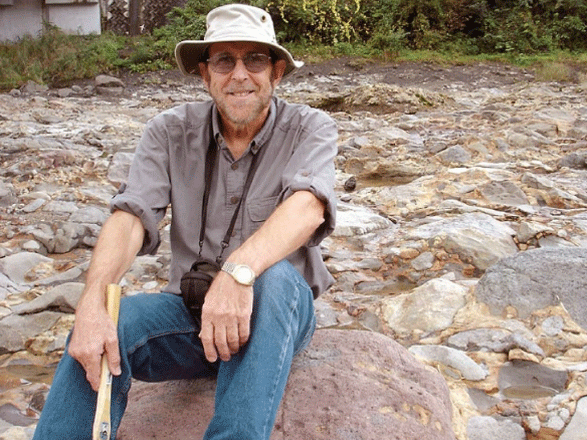Brief History
Jim Kennett was born and received his early education in Wellington, New Zealand. The wonderful geologic exposures of his native country, especially the Nelson area where his grandparents farmed, fostered a boyhood interest in geology. He received B.S. and Ph. D. degrees at Victoria University of Wellington where he began to meld his interests in Cenozoic stratigraphy, micropaleontology and the Antarctic with marine geology.
Henry Pantin from the New Zealand Oceanographic Institute convinced Kennett about the importance of the oceans for understanding global geology. At that time the United States was clearly well ahead in this frontier research. For this reason he and his wife Diana emigrated to the United States in 1966 largely to participate in the post Sputnik excitement and opportunities in science of the time. Jim had a postdoctoral fellowship with Orville Bandy at the University of Southern California where he continued working on Antarctic paleoclimatic history.
He began teaching at Florida State University in Tallahassee - a career spanning five decades of research and teaching at FSU, the Graduate School of Oceanography, University of Rhode Island and University of California Santa Barbara. The academic environment at the Graduate School in Rhode Island for 17 years was critical in advancing his experience in oceanography and marine geology.
Kennett's work in marine geology and paleoceanography since the middle 1960s contributed toward comprehensive understanding of major paleoceanographic and biotic changes that shaped the Cenozoic Era and its stratigraphic record, and their underlying causes. Because of these contributions, Kennett is considered a pioneer in developing paleoceanography as a new field and was founding editor of Paleoceanography.

Jim Kennett
In 1987, Jim moved with Diana to the University of California Santa Barbara as Director of the Marine Science Institute, serving for 10 years and also joining the Geology Department as Professor. On arrival at UCSB he initiated two research projects near the campus but with potential global implications. The first involved drilling and piston coring sediments in Santa Barbara Basin to better understand Quaternary climate change and its causes. The second was to push this record back through time using the locally uplifted and exposed Cenozoic sediments, especially the Miocene Monterey Formation. The 600-meter-deep Santa Barbara Basin is remarkable in containing a fine stratigraphic record with layers that can be divided as closely as single years, a phenomenon equivalent to tree rings in the ocean. For millions of years this region has been a highly sensitive recorder of climate change influenced by two competing currents, the cold California Current from the north and the warmer Countercurrent from the south. An abundance of microfossils adds to the record's quality.
In the early 1990s, the Ocean Drilling Program, successor to the Deep Sea Drilling Project, drilled a site in the basin, providing a gold mine of paleoclimatic information for last ice age. This provided Kennett and colleagues with a picture of surprisingly abrupt climate and oceanic changes, in turn raising the tantalizing question as to their triggering and feedback mechanisms. Thus we now know that the Earth's climate is highly prone to abrupt and major change, and therefore we need to be careful how we manage our planet that can be decidedly fickle in its behavior.
While at UCSB Kennett taught a range of courses about oceanography, Antarctica, geological oceanography, Earth System History, stratigraphy, paleoceanography and micropaleontology. He has been blessed with association of many wonderful graduate and undergraduate students and senior colleagues at UCSB and earlier locales who helped discover much about how our Earth has operated in its past.
Jim Kennett formally retired from teaching and administration in 2006 with the express purpose of actively focusing on various research projects. This work continues in earnest.